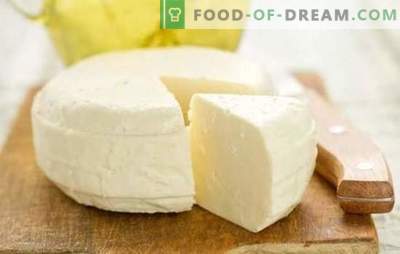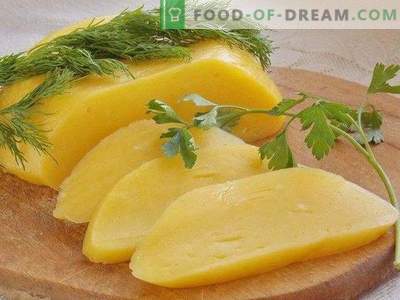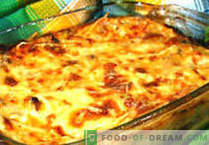
If you just say that suluguni is pickled cheese like cheese, Mozzarella, Adygei or Chechil, then this will be very little.
It is a visiting card of Western Georgia, a people who can glorify the beauty of the mountains and the vine, barbecue from lamb and, of course, made with love, suluguni cheese at home.
Georgians themselves do not pay attention to the scientifically substantiated origin of the name of cheese, denoting raw materials for its production.
With their characteristic poetic and romanticism, they explain that suluguni is a derivative of two words, soul and heart, and these words should be considered the basic conditions for making cheese. There is nothing to argue here.
Suluguni is of so ancient origin, and the process of its preparation is so painstaking that only a great love of earth and labor, the warmth of human hands could give people a refined, unique aroma and spicy taste of cheese, from the heart and soul.
Therefore, if there is an appropriate attitude, we will try to make a home suluguni.
There are only two recipes for cheese: the usual one, known to residents of sunny Georgia for many hundreds of years - such cheese can often be seen in the gastronomic departments of shops, and the second type of cheese, intended for long-term storage, and therefore smoked processed, can be bought and tasted only on historical homeland.
How to make suluguni cheese at home - basic technological principles
Suluguni has a white or creamy, soft and layered texture, creamy salty taste. The color shades of cheese depend on the quality of the milk - raw materials with high fat content gives a cream shade. Milk fat content varies depending on the conditions of animals, their age and other physiological factors, seasonal changes in the diet. The raw material for Suluguni cheese is cow or buffalo milk. Due to the geographical characteristics of animal husbandry, enterprises engaged in the production of Suluguni cheese use mainly cow's milk. Preparation of cheese consists of two main stages, each of which, in turn, can also be divided into separate operations.
At the first stage, in fact, they get fresh homemade cheese, like Imeretinsky, Health cheese and other curd cheeses. To do this, the milk is fermented, the whey is separated, the curd grain is subjected to self-pressing, kept for some time in brine. This cheese is already very fresh and tasty natural product.
To prepare suluguni cheese at home, the obtained cheese head is subjected to further mechanical processing and melting, and then a completely different type of cheese is obtained. When the cottage cheese cheese is pre-cut into small fractions, it melts and the cheese becomes plastic. It is kneaded like dough, pulling and folding layers, which allows for a layered texture.
Suluguni, which is made in production, is not governed by the state standard, but by the technical conditions of each individual enterprise. This suggests that a single technology for the production of Suluguni does not exist, and each company tries to recreate the cheese recipe in its own way. In fact, there is only one recipe for this homemade suluguni. The difference between the suluguni cheese at home and manufactured at the factory, according to the specifications, consists only in one nuance.
Homemade suluguni is made from fresh whole milk, bypassing the pasteurization stage. Given that the technology of making cheese involves repeatedly heating the cheese grain and cheese dough to a temperature above 85 ° C for 10-15 minutes, which allows you to protect the finished product from the presence of unwanted microorganisms in the process of maturation and storage of suluguni, there is no need for preliminary pasteurization of milk.
But in the production of Suluguni made from pasteurized milk, as required by strict sanitary standards. Therefore, there is a difference in the recipe of home and industrial methods of cooking cheese. Home-made cheese is notable for its special naturalness and simplicity of preparation - cheese grain is obtained for it naturally, without introducing calcium chloride and rennet, unlike the industrial method of making cheese from pasteurized milk. What are calcium salts and enzymes for? If explained simply, the pasteurization process loses their milk, so they are added artificially. This is the whole difference between home and industrial method of manufacturing Suluguni.
A detailed description of the first and second methods of home suluguni - in the recipes below.
1. Suluguni cheese at home from pasteurized whole milk
Raw materials:
- Farm, natural milk, pasteurized 12 l
- Calcium chloride 1.2 mg
- Rennet 2.4 mg
- Salt
Equipment and tools:
- Pans 8 l, 15 l and 20 l
- Wooden shovels 2 pcs.
- Round Colander (or Sieve)
- Large bowl for kneading cheese dough
- Long Kitchen Knife
- Cutting Board
- Tray for draining whey
- Temperature probe with timer (if possible)
Preparation Procedure:
- Pour the milk into the pan (15 l) and put it into a larger pot, set on the included cooker and partially filled with water. If there is no special saucepan for making cheese, then the method of cooking in a water bath will help out a lot - if in direct contact with fire, milk or cheese can be burnt. In a large pot, if necessary, you can add hot water to maintain the required temperature.
- Heat the milk to 35-38o C. If there is no special thermometer, you will have to navigate according to your own feelings - the temperature of fermentation of the milk should be slightly higher than the normal temperature of the human body. In such a situation it is better not to overheat.
- Pour 50 ml of warm boiled water into the measuring cups and dissolve calcium chloride and rennet in them separately. Use medical syringes for accuracy. The disadvantage, as well as the excess of these components will affect the quality of the preparation of curd and dough, for the worse.
- Pour the contents of the measuring cups into the milk and mix for 10-15 minutes until a milk clot forms.
- Do not forget to monitor the temperature of heating. In order to stably maintain it at the proper level, next to a large saucepan, place a saucepan to heat the water and maintain the temperature close to boiling. Prepare a dipper to take out the cooled water and top up the hot one.
- After 5-6 hours, the clot will become so dense that it can be transferred into the prepared molds installed on the drip tray. Turn the curd mass into forms with a skimmer so that you do not have to clutter up the workplace with large pallets. Transfer the remaining serum to sterile jars. It can be used later for other culinary or business purposes.
- Combine the forms with a clot when the whey drains a bit and the cheese is compacted. Turn one of the forms on the other and set aside. They will need to be turned from time to time so that the cheese is compacted under its own weight. Both halves should “grow together”, forming a cheese head with rounded sides, a regular cylindrical shape. To seal the cheese and whey drip by self-pressing method, 8 hours is sufficient.
- During this time, the cheese will acquire a dense texture. Put the head on a cutting board and tuck the surface with salt. Wrap the cheese in a film and put in the refrigerator for 2-3 days for ripening.
- This is one of the varieties of pickled cheeses, and it is already ready for use. But the main goal is the preparation of Suluguni, and therefore, two days later, proceed to the second, final stage.
- Put the cottage cheese cheese on a cutting board and cut it into small cubes. This is necessary so that when melting the cheese is evenly rolled and turned into a plastic dough.
- Pour hot water (85 ° C) into the basin and put the sliced pieces into it. Take in both hands wooden shovels and begin to mix the cheese until the moment when the pieces become a stretching consistency. Using blades, collect them into the total mass and knead until a single lump is formed. Watch the temperature of the water in the pelvis and constantly change it, draining the cooled down and adding hot from the pan, which at this time should be on the stove, at the ready.
- Continue kneading the cheese dough, kneading it in hot water into a flat cake and then immediately folding it to provide a layered texture. Put the ready dough into a ripening form installed on a tray. Soak for 2-3 hours in shape, in the refrigerator.
- At this time, prepare the brine (20%). For its preparation, you can use whey or hot water in which cheese dough was kneaded. Put the cheese in the brine for a day. After 12 hours, do not forget to turn the head upside down so that the suluguni is evenly salted.
- After transferring the head to the bag or container and store in a cold place.
2. Homemade Suluguni - recipe for fresh milk cheese
Raw materials:
- Fresh, whole milk, not pasteurized 10 l
- Salt
- Water
Preparation:
The entire order of cooking Suluguni is described in detail in the recipe number 1. The difference is only in the use of raw materials.
3. Suluguni cheese at home - recipe for fried suluguni
Products:
- Tomatoes
- Cilantro
- Suluguni
- Dill
- Sweet onions, red
- Vegetable oil, salt and pepper (for dressing)
- Parsley
Preparation:
Wash, peel and peel the onions and tomatoes in thin slices. Put in a baking dish. Sprinkle with chopped greens and pour dressing from ground pepper, salt and vegetable oil. Put a layer of rubbed suluguni on top. Put in the oven and bake until golden brown.
4. Home Suluguni - recipe of Georgian cuisine “Achma”
Products:
- Water 150 ml
- Eggs 3 +1 pcs.
- Salt
- Butter, cream (melted) 180 g
- Flour 0.8 kg
- Suluguni 500 g
Preparation Procedure:
Cheese rub. Beat the eggs (3 pcs.), Adding water and salt. Add the mixture to the sifted flour, knead the dough. Divide it into seven parts, two of which should be 70-100 g more. Roll the balls and cool. Place a pot of water on the stove, add salt and bring to a boil. Five small pieces of dough, remove and roll circles of 20 cm in diameter. Make circles of 28 cm in diameter from large pieces of dough. Cover the round baking sheet with oiled parchment. At the bottom lay a large circle, lubricate it with oil and sprinkle with grated suluguni. The edges of the large circle should hang from the side. Place a small circle in boiling water for half a minute, remove with a slotted spoon and immediately place it on top of the cheese layer in the form. Lubricate with butter and sprinkle with cheese. Dip the following small circle in boiling water and repeat the operation. Putting the cooked dough in layers, cover the product with a second large circle, pinch the edges, connecting them. Top grease the dough with egg and bake for half an hour at 200-210 ° C. Put the finished baking on a plate and cut.
5. Suluguni cheese at home - blue eggplants with tomatoes and cheese
Products:
- Blue Eggplants
- Sulug Cheese
- Garlic
- Salt
- A mixture of ground peppers
- Salt
- Greens for decoration
- Tomatoes
Preparation Method:
Cut the prepared eggplants in half lengthwise. Fry in vegetable oil. Prepare a mixture of garlic, salt, chopped greens and salt, and rub it inside the eggplant. Top with thin slices of tomatoes, sprinkle with grated cheese. Vegetables put on a baking sheet, greased with fat and send for fifteen minutes in a preheated oven. When the cheese is reddened, spread on a dish, sprinkled with herbs.
6. Homemade Suluguni - Salad Recipe
Ingredients:
- Suluguni
- Boiled fillet, chicken
- Fresh Cucumber
- Basil, parsley
For refueling:
- Grape Vinegar (or Lemon Juice)
- Olive Oil
- Spices, sugar and salt
Preparation:
All ingredients cut into straws in equal proportions. Stir and pour the dressing to taste before serving. Salad can also be cooked with smoked chicken.
Suluguni cheese at home - tips and tricks
- To prepare one kilogram of suluguni, 10-12 liters of natural milk are required. The error in volume is due to the quality of milk, which may, objectively, contain different amounts of dry matter.
- Fresh Suluguni is stored in a container in the refrigerator. Its shelf life is up to 30 days. For longer storage cheese is smoked























